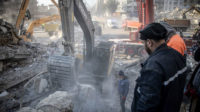Viewpoint
Anatomy of Failure: The Turkey Earthquake Disaster
Kit Miyamoto, founder of Miyamoto International, reflects after tour of disaster zone from Febuary 6 quake

Rescuers dig through a collapsed building in the days following the devastating Feb. 6 earthquakes in Turkey.
Photo Courtesy Miyamoto International
As I board the 11-hour overnight bus to Istanbul from the disaster zone, my mind is still reeling from the destruction I have witnessed on the Syria–Turkey border. The scene of devastation is unlike anything I have seen in my 20 years of working in disaster zones.
Yesterday, I carefully made my way through the twisted metal, broken concrete and bricks of the ancient city of Hatay, once called Antioch in ancient time. The destruction was so complete that I could barely imagine what the city looked like before the disaster. Narrow streets filled with commerce, bustling restaurants and apartments are now gone. The tremors that shook the city Feb. 6 destroyed 90% of its buildings, and the total death toll has surpassed 45,000.
[Editor's note: This account was written in the weeks immediately following the earthquake. According to more recent estimates, the death toll in Turkey now is estimated at over 50,000, with more than 100,000 wounded.]
The city is situated a couple of hundred kilometers away from the ruptured fault line, but it rests on a soft riverbed that amplified the motion of the earthquake. This, combined with the old building stock, created a deadly situation. Many modern mid-rise buildings, including those made of concrete, were destroyed, or tilted. The situation reminded me of a picture of Hiroshima after the nuclear blast.

Our team assessed many affected cities last week and formulated recovery strategies based on how the government reacted and the international funds’ strategy. We also met and assisted countless citizens in their broken homes. We estimated that 10,000 structures have collapsed, and an additional 20,000 buildings may need to be demolished due to extensive damage. This is in addition to the 100,000 buildings that sustained damage, making them uninhabitable. As a result, 2.5 million people were instantly homeless.
Turkey changed its building code in the late 1990s by implementing earthquake-resistant designs. Therefore, anything built before the 2000s, especially older concrete structures on soft soil, were deemed dangerous, as we saw in Hatay. While these buildings could have been retrofitted to be stronger, it takes public support and political will to do so. Unfortunately, such efforts usually only happen after a major disaster.
The most devastating fact is that there is no enforced quality assurance in Turkey’s construction industry. There is no licensing for contractors or engineers, which results in anyone being able to become one. Additionally, there is no requirement for quality supervision of construction by engineers.
Our team and I went through many collapsed modern construction sites, and while they fared better than older ones, many still collapsed. Small details matter in earthquakes, and there were many critical misinstalled elements, such as steel hoops in concrete pillars that support the upper floors. If these pillars fail, there will be nothing to protect the inhabitants.
Smooth river pebbles were often used as aggregate in concrete instead of small, rugged rocks that are essential to bind cement together. Engineers must be on site to check these small details—90% right is not good enough when 7.8- and 7.5-magnitude earthquakes happen back-to-back.
Contrary to media reports, I saw that the government’s response was decisive, quick and effective in a widespread area.
The affected zone is a 300-km-long and 200-km-wide mountainous area, which is not an easy place to access. A Turkish government agency called AFAD, which is equivalent to FEMA in the U.S., spearheaded the effort. It provided 150,000 warm tents in the first few days of the disaster and coordinated a 10,000-member international search-and-rescue team that saved hundreds of lives.
All primary and secondary roads were opened by the end of the first week, and the damaged Hatay airport was opened simultaneously. The agency even started demolishing dangerously damaged buildings within a few days. I have no idea what media is talking about, but this is one of the most efficient emergency responses I have ever seen.
The Turkish government has declared that it will reconstruct all 30,000 mid-rise apartments, and I am confident it will. Turkey's construction industry is robust and massive. If any country can build back stronger and better on this scale, it will be Turkey. It is a country of determined people.
Kit Miyamoto is a structural engineer and founder of Miyamoto International, a global engineering firm that provides expert advice and assistance in disaster zones.


